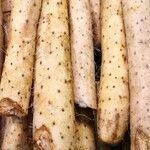Tubers vertical, cylindric, to 1 m; transverse section white. Stem twining to right, often purplish red, glabrous. Bulblets present in leaf axils. Leaves alternate basally on stem, mostly opposite distally on stem, rarely in whorls of 3, simple; petiole 2--3 cm; leaf blade often drying grayish or greenish, ovate-triangular to sagittate, usually 3-lobed, relatively wide and ± entire on juvenile leaves, 3--7(--16) × 2--7(--14) cm, papery to thinly leathery, glabrous, basal veins 5 plus 1 or 2 pairs restricted to basal lobes, base shallowly (rarely to deeply) cordate to subtruncate, apex acuminate; lateral lobes auriculate, subrectangular to oblong, rounded. Male spikes 2--8 together, erect, 2--8 cm, rarely paniculate; rachis obviously zigzagged. Male flowers: sessile; bracts triangular-ovate, ca. 1 mm; perianth yellow with purplish brown dots, outer lobes broadly ovate, 1.3--2 × 0.8--1.2 mm, concave, inner ones ovate, smaller than outer; stamens 6. Female spikes solitary or 2 or 3 together. Capsule not reflexed, oblate or globose, (1.2--)1.7--2 cm, pruinose; wings 0.7--1.5 cm wide. Seeds inserted near middle of capsule, winged all round. Fl. Jun--Sep, fr. Jul--Nov.
A yam. The stem is angled, twines to the right and is often purple. The tubers can be 90 cm long. There can be bulbils along the vine. The leaves are alternate lower on the stem and opposite higher up. The leaves are oval and heart shaped at their base. The leaf stalks are shorter than Potato yam. The leaves are simple and the leaf stalk is 2-3 cm long. The leaves can be triangular or with 3 lobes. The flowers are white and smell like cinnamon. The tubers are vertical and like a cylinder and up to long. The flowers smell of cinnamon.
Perennial from deep-seated tubers to 1 m, the slender stems climbing 1–5 m and twining clockwise; lvs alternate, opposite, or ternate, usually with a small axillary tuber, the blade about as wide as long, halberd-shaped, deeply cordate at base; fr probably never produced in our range; 2n=ca 140–144. Native of China, often escaped from cult. in U.S. and occasional in our range. (D. batatas)

